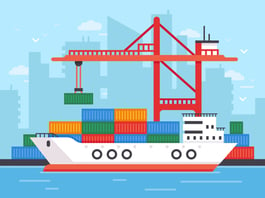Good exporters focus on building good relationships and getting deals done: negotiating mutually acceptable terms with a buyer and codifying that agreement into a sales contract.
And once that’s accomplished, many think that the hard work is done: get the ULDs or containers or pallets on their way, then sit back and wait for the cash to make its way into your bank account. Cha-ching.
Unfortunately, there’s often a second document involved, one that can be completely disconnected from all the terms you’ve agreed on… and one that can delay receipt of payment or even scuttle the whole sale over a typo!
That document is the Letter of Credit.
Letter of Credit
is a document created by a financial institution that gives the seller (exporter) a guarantee that the buyer is good for the money, and that the bank will assume the risk of covering payments in full and on time if the buyer can’t or won’t.
Letters of Credit are still overwhelmingly popular as trade finance instruments. Although usage has been dropping as financial institutions experiment with new payment and trust models, our experience shows that over half of trades in many major markets still rely on a Letter of Credit.
The Letter of Credit is drawn up based upon the sales contract, but is thereafter a separate stand-alone document. Banks will honor their commitment to cover the seller’s invoice, but only if there is 100% compliance with the terms of the Letter of Credit - specifically the exact execution of trade documentation, without exception. Payment to the seller is conditional exclusively only on their ability to generate a specifically denominated document set, with no other “real world” considerations. (Sidebar: early in my career I was responsible for typing up export documents - on what was then a nearly new IBM Selectric, if you want to make me feel old! - and had documents rejected for discrepancies as minor as a missing period after “Inc” or a comma instead of a semi-colon in a product description.)
A Letter of Credit is only concerned with documents that provide evidence of a specific transaction taking place, not the real world objects or actions that those documents represent. Letters of Credit are constructed such that each document provides the buyer a “proof” - proof that they are getting what they ordered, proof that the goods will be delivered where and when agreed on, proof that legal and compliance requirements have been addressed and won’t hold up delivery of the shipment.
What does an L/C consist of?
A typical Letter of Credit will require presentation of 5 types of documents:
- Commercial Documents (proving the goods are what was contracted for) - packing list, certificate of origin, inspection certificate.
- Shipping and Transport Documents (proving the goods are on their way and will be delivered to the buyer within agreed-upon timeframe) - bill of lading.
- Insurance Documents (proving the goods were adequately insured throughout the transport process) - certificate of insurance.
- Official Documents Required by Buyer/Importer’s Country (proving the goods are in such condition that they will be allowed to be imported into buyer’s country) - phytosanitary / health certificate, inspection report, other country- or commodity- specific certificates.
- Financial Documents (proof of value of goods and negotiable instrument allowing payment) - commercial invoice, consular invoice, draft or bill of exchange.
The Monkeywrench
For well over a century, standard practice has been for the seller to collect all the required documents, vet them for accuracy and compliance, then start a chain of courier packages that flow around the world - exporter to their freight forwarder (or an outsourced L/C compliance service), freight forwarder to seller’s bank, seller’s bank to buyer’s bank, buyer’s bank to buyer. Any party in the chain can sell the debt to a 3rd party for a discount, involving another forwarding of documents. At each stage, the documents are again pulled out, reviewed and vetted, and then forwarded on.
Getting this right means the difference between being paid in 15-20 days, 40-60 days, or possibly never!
Our experience is that in the best case just moving the papers around the world takes 15-20 days, and payment takes a minimum of 45 days from the time of shipment. Worst case, the documents are rejected and returned back up the chain to the seller to make corrections and start again from scratch.
How to Get it Right
Managing this process “the old way” takes discipline, organization, and precision. And still there is a high likelihood for error and delay. Great exporters have figured out how to deliver and get paid faster!
Their secret is to eliminate any areas where inaccuracy or delay can be introduced.
Great exporters have a document generation and storage system that integrates into their ERP and/or TMS, reducing the error rates inherent in manual document creation and submission. While most banks still require hard copy documents be presented, many documents can now be generated electronically and printed at the last minute (with the exception of the Ocean Bill of Lading original copy, which is issued by the ocean carrier or third-party logistics provider and needs to be physically stamped and signed by them). Insurance companies, inspectors, Chambers of Commerce, even many government bureaus now often encourage fully electronic document generation and transmission.
Great exporters also set up automated workflows to push the order through from sale to shipment to delivery to payment, ensuring that nothing falls between the cracks and derails the process. In our experience, we’ve seen error rates plunge from this automation - and cash cycles shorten by more than half.
Take lessons from the great exporters - the key to a faster cash cycle is automating as much of the trade cycle as possible.
TradeLanes is the new way that businesses trade with other businesses. We are an online platform built for global trade automation – enabling businesses to transact seamlessly, efficiently, and faster with their customers around the world. To learn how you can remove up to 20 days from your shipment-to-cash cycle, please contact us at +1-888-253-6580






Leave a Comment